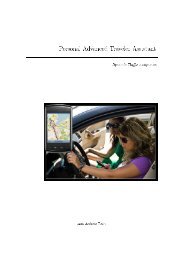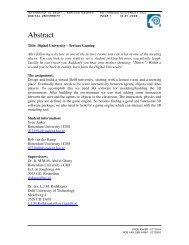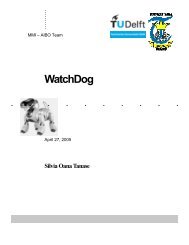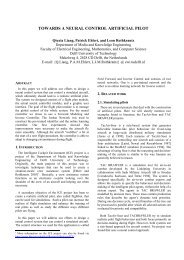Recognition of facial expressions - Knowledge Based Systems ...
Recognition of facial expressions - Knowledge Based Systems ...
Recognition of facial expressions - Knowledge Based Systems ...
Create successful ePaper yourself
Turn your PDF publications into a flip-book with our unique Google optimized e-Paper software.
available as part <strong>of</strong> the knowledge <strong>of</strong> the system.<br />
Moreover, the labeled patterns associated with<br />
each area are stored (see Figure 4).<br />
The computation <strong>of</strong> the eigenvectors was done<br />
<strong>of</strong>fline as a preliminary step <strong>of</strong> the process. For<br />
each input image, the first processing stage<br />
extracts the image data according to the three<br />
areas. Each data image is projected through the<br />
eigenvectors and the pattern with the minimum<br />
error is searched.<br />
Figure 3. The model <strong>facial</strong> key points and areas<br />
The label <strong>of</strong> the extracted pattern is then fed to<br />
the quantification function for obtaining the<br />
characteristic output value <strong>of</strong> each image area.<br />
Each value is further set as evidence in the<br />
probabilistic BBN.<br />
dynamic. The static parameters handle the local<br />
geometry <strong>of</strong> the current frame. The dynamic<br />
parameters encode the behavior <strong>of</strong> the key points<br />
in the transition from one frame to another. By<br />
combining the two sorts <strong>of</strong> information, the<br />
system gets a high efficiency <strong>of</strong> expression<br />
recognition. An alternative is that the base used<br />
for computing the variation <strong>of</strong> the dynamic<br />
parameters is determined as a previous tendency<br />
over a limited past time. Each parameter on the<br />
lowest layer <strong>of</strong> the BBN has a given number <strong>of</strong><br />
states. The purpose <strong>of</strong> the states is to map any<br />
continuous value <strong>of</strong> the parameter to a discrete<br />
class. The number <strong>of</strong> states has a direct influence<br />
on the efficiency <strong>of</strong> recognition. The number <strong>of</strong><br />
states for the low-level parameters does not<br />
influence the time required for obtaining the final<br />
results. It is still possible to have a real time<br />
implementation even when the number <strong>of</strong> states<br />
is high.<br />
The only additional time is that <strong>of</strong> processing<br />
done for computing the conditioned probability<br />
tables for each BBN parameter, but the task is<br />
run <strong>of</strong>f-line. According to the method used, each<br />
<strong>facial</strong> expression is described as a combination<br />
<strong>of</strong> existent Action Units (AU).<br />
Table 1. The used set <strong>of</strong> Action Units<br />
Figure 4. Examples <strong>of</strong> patterns used in PCA<br />
recognition<br />
6 Data preparation<br />
The Bayesian Belief Network encodes the<br />
knowledge <strong>of</strong> the existent phenomena that<br />
triggers changes in the aspect <strong>of</strong> the face. The<br />
model does include several layers for the<br />
detection <strong>of</strong> distinct aspects <strong>of</strong> the<br />
transformation. The lowest level is that <strong>of</strong><br />
primary parameter layer. It contains a set <strong>of</strong><br />
parameters that keeps track <strong>of</strong> the changes<br />
concerning the <strong>facial</strong> key points. Those<br />
parameters may be classified as static and<br />
One AU represents a specific <strong>facial</strong> display.<br />
Among 44 AUs contained in FACS, 12 describe<br />
contractions <strong>of</strong> specific <strong>facial</strong> muscles in the<br />
upper part <strong>of</strong> the face and 18 in the lower part.<br />
The table 1 presents the set <strong>of</strong> AUs that is<br />
managed by the current recognition system.<br />
An important characteristic <strong>of</strong> the AUs is that<br />
they may act differently in given combinations.<br />
According to the behavioral side <strong>of</strong> each AU,<br />
there are additive and non-additive<br />
combinations. In that way, the result <strong>of</strong> one nonadditive<br />
combination may be related to a <strong>facial</strong><br />
129
















